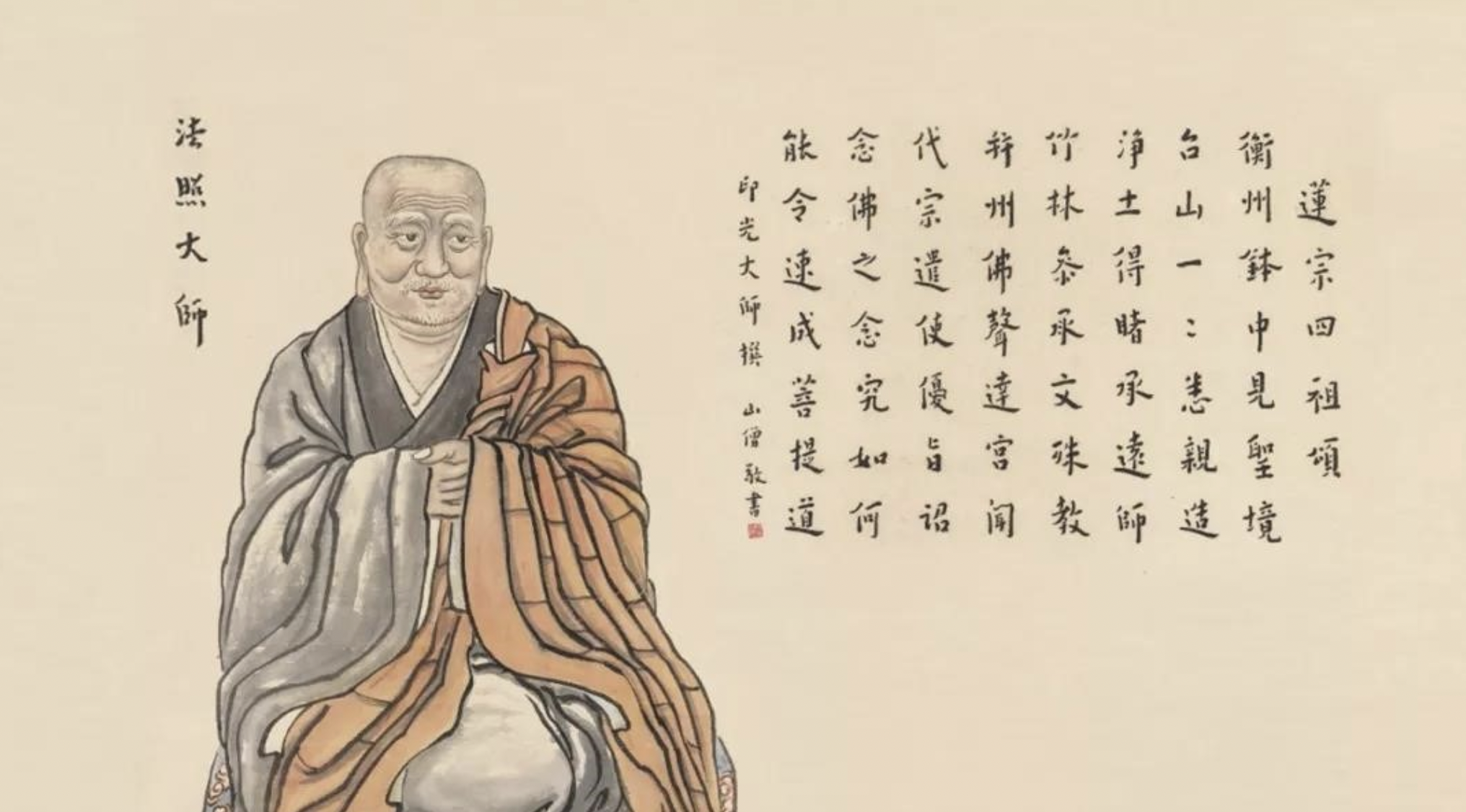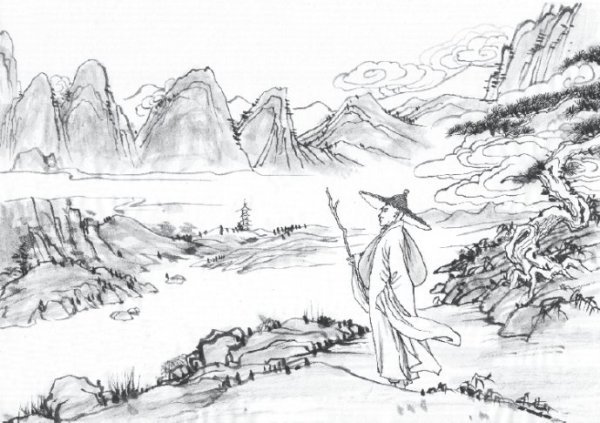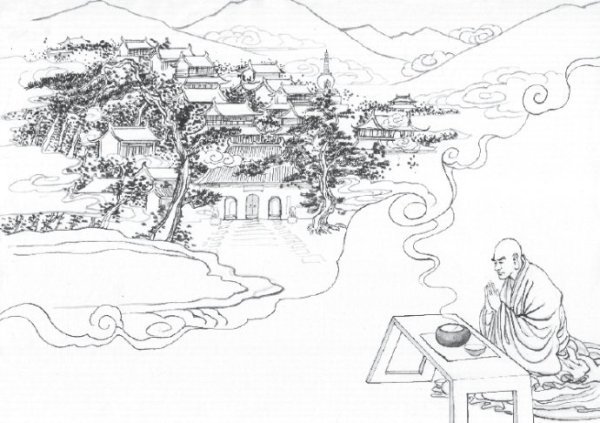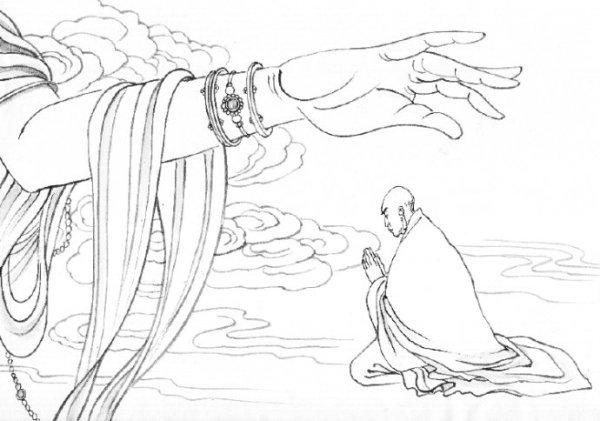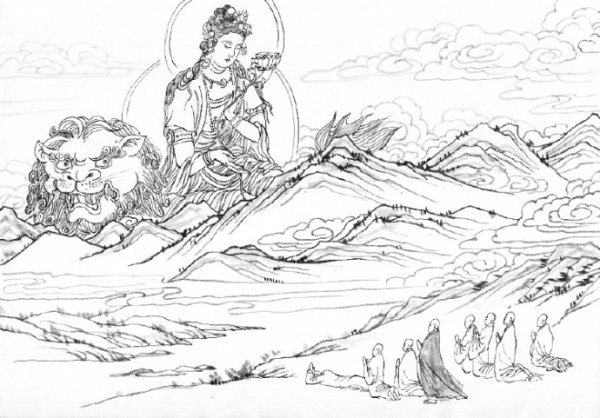4th Patriarch Great Master Fazhao 四祖法照大师
Great Master Fazhao (法照大师) is the fourth patriarch of Chinese Pure Land Buddhism. He was born during the Tang Dynasty in 747 C.E. (747 - 821), in what was known as Yanzhou Xingshi County (洋州兴势县) in Shaanxi Province (nowadays Yang County in Shaanxi Province (陕西省洋县).
Master Fazhao became a monk at the age of 11. He admired the first patriarch Master Huiyuan’s cultivation very much and went to Mount Donglin to single-mindedly cultivate Nianfo Samadhi. One day, while in meditation, he saw himself wandering in the Western Pure Land of Ultimate Bliss, and saw a monk wearing shabby clothes standing next to Amitabha Buddha. He asked who this monk was. The Buddha replied, “This is Master Chengyuan (承远大师) from Mount Heng of Nanyue (南岳衡山). He single-mindedly vowed to attain rebirth in the Pure Land. Because of his Nianfo cultivation, he has manifested his actual appearance here. Master Fazhao was very surprised by this and admired Master Chengyuan (who was the third patriarch of Chinese Pure Land Buddhism) very much. He wished to see Master Chengyuan right away.
After receiving the hint from the Buddha, the master immediately went straight to Mount Heng of Nanyue. In the first year of Emperor Yongtai of the Tang Dynasty (765), he came to Nanyue and saw Master Chengyuan under a cliff. Master Chengyuan was wearing the exact same clothes as Master Fazhao saw him wear in the Land of Ultimate Bliss. Master Fazhao couldn’t help but shed tears of joy. He began to study under Master Chengyuan and practiced Nianfo intensively at Amitabha Bozhou Temple (弥陀台般舟道场, nowadays Zhu Sheng Temple in Nanyue (南岳祝圣寺).)
[Editor’s note: Bozhou means Pratyutpanna, derived from the Pratyutpanna Samādhi Sūtra (般舟三昧经). This is the most difficult form of Nianfo practice. The full practice developed by Master Zhiyi is 90 days long. The practice includes constant walking and praying to Amitabha, sometimes accompanied or helped by a bystander. The practitioner should avoid sitting, laying down, resting or sleeping during the period of practice. The bystander would warn the practitioner if he or she engages in prolonged resting. Very few Buddhists practice this nowadays. Master Yinguang suggested that people should practice the much easier Nianfo instead.]
At that time, Master Chengyuan’s Bozhou temple was the most prosperous Buddhist temple in the south of the Yangtze River. Tens of thousands of people followed Master Chengyuan. Master Fazhao practised the Nianfo Dharma gate diligently and received the true transmission of the Pure Land teachings from Master Chengyuan.
In the summer of the second year of Yongtai (766), while Master Fazhao was diligently practising his fourteenth night of Pratyutpanna Nianfo, he again went to Amitabha Buddha in the Pure Land. He asked the Buddha to share the wonderful Dharma. The Buddha said, “There is a priceless Fivefold Assembly Amitabha Chanting Dharma gate which is very suitable for that turbid and evil world.” After that, he made great vows and generated the unsurpassed bodhicitta, and established the Fivefold Assembly Nianfo (五会念佛) according to the Infinite Life Sutra and under the guidance of Amitabha Buddha.
In the year 767, Master Fazhao left the Bozhou Temple and settled in Yunfeng Temple to diligently continue his cultivation. One day, while having his meal in the dining hall, the Great Master suddenly saw auspicious, five-coloured clouds, temples, mountains, forests, streams and stone gates, etc. from the alms bowl. About five lis away from the stone gate (li is an ancient measurement in China; 1 li = 500 metres), he saw a temple named “Great Sage Bamboo Grove Temple (大圣竹林寺)”.
After a few days, while he was dining, he again saw that within the alms bowl were auspicious, five-coloured clouds, temples and temple pavilions, all of which were supreme. They consisted of pure gold, intertwined with all kinds of treasures, and the great sage Manjushri and thousands of Bodhisattvas were among them. All kinds of wonderful phenomena appeared to the master, like the Pure Land of the Buddhas. Only when the meal was over did the holy realm in the bowl disappear. The master told some monks about what he had seen. There were two monks named Jiayan and Tanhui who told him, “The sages’ spiritual power cannot be measured by us ordinary beings, but according to the shapes of the mountain you described, it seems to have been Mount Wutai (五台山).” Knowing this to be the holy Mount Wutai, the master vowed to pay homage to the mountain, but due to various obstacles he couldn’t fulfil his wish (Mount Wutai is one of four major Buddhist mountains in China and is the bodhimanda of Bodhisattva Manjushri.).
In the summer of the year 769, the Great Master established the Fivefold Assembly Nianfo Bodhimanda (practising centre) at East Lake Temple in Hengzhou. It attracted the auspicious response of five-coloured clouds, which completely enveloped the monastery. Within the auspicious clouds appeared pavilions and temples. Amitabha Buddha and two Bodhisattvas (Guanyin and Dashizhi) filled the entire sky with their enormous bodies. All the people from Mount Heng witnessed this clearly, and they all prostrated reverently. They paid homage and made offerings of incense to the Buddha and Bodhisattvas. The scene continued for four hours before disappearing.
The master met an old man in the monastery that night who asked him, "Master once vowed to pay homage to Mount Wutai. Why haven’t you gone yet?" The master replied, "There are many obstacles and the journey is long. How can I possibly get there?" The old man answered, “As long as you are determined, how can the long and rugged road stop you?" After saying this, he disappeared. Master Fazhao was astonished and delighted. He again vowed before the Buddha statue that once the Nianfo assemblies were over, he would set off for the pilgrimage to Mount Wutai. Even if fires gathered and rivers froze, he would never retreat. After that, he gathered a few like-minded people with the same aspiration to set out on the road, and the journey indeed went smoothly.
In the year 770, on the sixth day of the fourth lunar month, the Great Master and four others reached the Buddha Light Temple in Mount Wutai. In the evening, there was a light from afar that shone on Master Fazhao’s body. He immediately followed the light and walked about 50 li (about 250 metres). He encountered a mountain with a stream at its foot. There was a stone gate to the north of the stream. He met with two boys who claimed to be "Shancai (Sudhana)" and "Nanda" who led him to the Great Sage Bamboo Grove Temple. What he saw there was exactly like what he had seen in his alms bowl. He walked into the temple, entered the Dharma hall and saw Manjushri Bodhisattva in the west, and Samantabhadra Bodhisattva in the east, each sitting on the lion seat, preaching the Dharma, surrounded by tens of thousands of beings. The sound of Dharma could be heard clearly.
After reverently prostrating to the two great Bodhisattvas, the Great Master asked, 'In the Dharma-Ending Age, the ordinary beings are so far away from the sages, with little knowledge, heavy karmic obstacles and defilements. One’s Buddha nature cannot be revealed. In the vast and profound Buddha Dharma, which is the most suitable Dharma gate for all beings?”
Manjushri Bodhisattva answered, “Just as you are doing now, Nianfo is the best. Amongst all Dharma gates, none can surpass Nianfo. There is also another gate, which is to make offerings to the Three Jewels. This is referred to as ‘cultivating blessings and wisdom together.’ These two Dharma gates are the most essential and efficient. In the past eons, I have gained all encompassing wisdom because of meditating on the Buddha, because of chanting the Buddha's name (Nianfo), and because of making offerings. Therefore, all dharma, Prajna Paramita, deep meditation, and even all Buddhas are born from reciting the name of Amitabha Buddha. Therefore, you should know that reciting the name of Buddha is the king of all dharma, you should always think of the supreme Dharma king uninterruptedly.
The Great Master than asked, “How should one practise Nianfo?” Manjushri Bodhisattva responded, “To the west of this world, there is a Buddha called Amitabha. Amitabha’s vows are inconceivable. You should practise Nianfo uninterruptedly, and you will definitely be able to attain rebirth at the end of your life, to the stage of non-regression.”
Upon finishing speaking, Manjushri and Samantabhadra extended their golden arms and patted the crown of the master’s head, bestowing upon him a prediction of Buddhahood, “You will soon realise the unsurpassed supreme Bodhi due to the causes and conditions of Nianfo. If there is a good man or woman who wants to become a Buddha and quickly attain supreme wisdom, there is no faster method than to recite the name of Amitabha Buddha!" The two great sages then each spoke in verse. After listening to what the Bodhisattvas has to say, the Great Master eliminated all his doubts. He was filled with joy, paid respect and prostrated to them as they departed. In an instant, the entire scene disappeared. Feeling a mix of joy and sorrow, the Great Master used a piece of stone to mark the spot where this marvelous event took place.
On the 13th day of the fourth lunar month, Master Fazhao and fifty monks arrived at the Diamond Cave on Mount Wutai. They prostrated reverently to the Thirty-five Buddhas of Confession. After the tenth prostration, Master Fazhao found himself manifested in a grand, solemn and pure palace made of Lapis Lazuli. The Bodhisattvas Manjushri and Samantabhadra were both present. After this vision, Master Fazhao returned to the Diamond Cave alone, and vowed to see Bodhisattva Manjushri. When he sincerely prostrated, he saw the Indian monk Buddhapāla (佛陀波利) who directed him to a temple, where a sign read, “Vajraprajñā Temple”. Inside the temple there was abundance of all kinds of wondrous jewels, shining brightly. The Great Master saw Bodhisattva Manjushri in the great hall, whose dignity was unparalleled. Upon witnessing this scene, Master Fazhao’s faith was deepened even further and he strove to practise Nianfo more diligently.
The Great Master had encountered many supernormal incidents, but he never really told anybody. In the twelfth lunar month of the same year, Master Fazhao travelled to Huayan (Avatamsaka) Temple. He was determined to refrain from eating anything and only practise Nianfo to attain rebirth into the Pure Land. In the evening of the seventh night, an Indian monk came to the temple and told him, “The supernatural phenomena of Mount Wutai that Master saw should be revealed to all living beings, so that they can all develop bodhicitta and gain great benefit. Why haven’t you revealed it?"
The master replied, “It’s not that I want to hide it intentionally, but I’m afraid that some people will doubt and slander me after hearing about it.” The old monk then said, “Great sages like Manjushri Bodhisattva who are in this mountain are still being slandered by people. What do you have to worry about? This is simply to let all living beings hear about you experiences and develop bodhicitta so they may become associated with the great sage Manjushri." So the master recalled the incredible scenes he had seen and recorded them in a book. This became known as the "Records of the Great Sage Bamboo Grove Temple (大圣竹林记)" by Master Fazhao.
Master Fazhao’s diligent cultivation especially included the Fivefold Assembly Nianfo. The emperor at that time was Tang Daizong (唐代宗), who often heard the sound of Nianfo coming from the northeast direction. He eventually sent someone to look for the source of the sound, and found Master Fazhao teaching Nianfo. The emperor invited Master Fazhao to the Imperial Palace to teach the people on how to Nianfo. Master Fazhao was soon regarded as “teacher of the country (国师)”. This is the first time in Chinese history where an emperor invited a monk to teach Nianfo to the people in the Imperial Palace.
In the year 777, the Great Master led eight of his disciples to Nianfo on Wutai Mountain. They saw auspicious and colourful clouds and lights from the east platform. Manjushri Bodhisattva appeared riding a green-haired lion. Snowflakes fell from the sky, and Manjushri Bodhisattva's five-coloured, round mandorla shone all across the valley. The master has practiced the Nianfo Dharma gate diligently and experienced many extraordinary sights that are too numerous to describe. He was later inspired to write the “Praise of Five Assemblies Nianfo Dharma Rites and Rituals”.
When he was in Chang'an (the capital of ancient China at that time), Master Fazhao often went into the streets to teach sentient beings on the method of Nianfo. Many people followed him, received the precepts and adopted a vegetarian diet. At that time, there was a butcher in the city. Because many people abstained from killing and followed a vegetarian diet, his business was affected greatly. Filled with hatred, the butcher concealed a knife and went out, harbouring a perverse intent to murder the master. The master understood the man's thoughts through his telepathy, and took the initiative to see the butcher himself. He asked the butcher, "Do you wish to fall into hell? Then come and kill me!" The butcher was stunned, threw the knife to the ground, hurriedly prostrated and repented, willing to take refuge and recite Amitabha Buddha’s name.
One day during his Nianfo meditation, Master Fazhao saw the Indian monk Buddhapāla and told him, “Your Pure Land lotus has already formed. After three years, it will open.” After three years, the Great Master told the assembly, “I will now attain rebirth (in the Pure Land).” He sat in a meditative position and departed peacefully. Because of Master Fazhao’s diligent cultivation and effort to share the Pure Land Dharma gate to save sentient beings, he was regarded as the fourth patriarch of Chinese Pure Land Buddhism.

